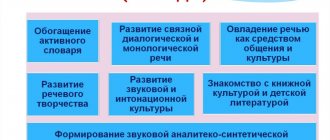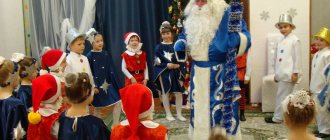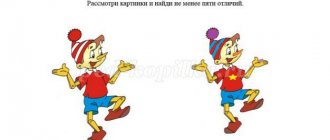Main tasks, content for children's speech development.
About the tasks of speech development
First published in the magazine "Preschool Education". 1975. No. 9
F. SOKHIN
One of the important tasks of education and training in kindergarten is the development of speech and teaching the native language. This general task includes a number of specific tasks: nurturing the sound culture of speech, enriching, consolidating and activating the vocabulary, improving the grammatical correctness of speech, teaching colloquial (dialogical) speech, developing coherent monologue speech, cultivating interest in the artistic word, preparing for learning to read and write. Let's consider some of the listed tasks.
Children, mastering their native language, master the most important form of verbal communication - oral speech. Speech communication in its full form - understanding speech and active speech - develops gradually.
The formation of verbal communication between a child and an adult begins with emotional communication. It is the main content of the relationship between an adult and a child during the preparatory period of speech development (in the first year of life). The child responds with a smile to the smile of an adult, makes sounds in response to a gentle conversation with him, to sounds uttered by an adult. He seems to be “infected” by the adult’s emotional state, his smile, laughter, and gentle tone of voice.
In emotional communication with an adult, a child reacts to the characteristics of the voice, the intonation with which words are pronounced. Speech participates in this communication with its sound form, intonation, accompanying the actions of an adult. The semantic content of the speech is incomprehensible to the child.
In emotional communication, an adult and a child express their general attitudes towards each other, their pleasure or displeasure, and express feelings, not thoughts. This becomes completely insufficient when in the second half of the year the baby’s relationship with an adult (as well as with other children) is enriched, his movements and actions become more complex, and his cognitive capabilities expand. Now it is necessary to talk about many interesting and important things around, and in the language of emotions it is sometimes very difficult to do this, and most often it is simply impossible. We need the language of words, we need verbal communication between an adult and a child.
In a situation of emotional communication, the child is initially interested only in adults. But when an adult attracts his attention to something else, he seems to switch this interest to an object, an action, to another person. Communication does not lose its emotional character, but it is no longer actual emotional communication, not an “exchange” of emotions for their own sake, but communication about the subject. The word spoken by an adult and heard by a child, bearing the imprint of emotions (in such cases it is pronounced expressively), is already beginning to be freed from the captivity of emotional communication, and gradually becomes for the child a designation of an object, action, etc. On this basis, from the second During the first six months of life, the baby develops an understanding of words and speech. Elementary, incomplete verbal communication appears, since the adult speaks, and the child responds only with facial expressions, gestures, movements, and actions. The level of such understanding is sufficient for the child to be able to meaningfully respond to comments, requests and demands in everyday situations that are well known to him. At the same time, the baby’s proactive approach to adults also develops: he attracts their attention to himself, to some object, and asks for something using facial expressions, gestures, and sounds.
Pronouncing sounds during an initiative address is especially important for the development of verbal communication - this is where the intentionality of speech arises, its focus on another person. It is equally important to imitate the sounds and sound combinations that an adult pronounces. It contributes to the formation of speech hearing, the formation of arbitrary pronunciation, and without it it is impossible to imitate whole words, which the child will later borrow from the speech of surrounding adults.
The first meaningful words appear in a child’s speech usually by the end of the first year. They, however, are not very suitable for verbal communication with adults. Firstly, there are not enough of them - only about ten (“mother”, “grandfather”, “yum-yum”, “aw-aw”, etc.). Secondly, the child very rarely uses them on his own initiative.
Around the middle of the second year of life, a significant shift occurs in the development of a child’s speech: he begins to actively use the vocabulary accumulated by this time in order to address an adult. The first simple sentences appear.
A characteristic feature of these sentences is that they consist of two words, used in an unchanged form (three- and four-word sentences appear later, by the age of two): “ise maka” (more milk), “maka boil” (milk is boiling) , “Kisen Petska” (jelly on the stove), “Mama Bobo” (Mom is in pain) . Even such imperfect grammatical structure of a child’s speech significantly expands the possibilities of his verbal communication with adults.
By the age of one and a half years, a child speaks about one hundred words; by two years, his active vocabulary increases significantly - up to three hundred words or more. Individual differences in speech development can be very large, and the data given are, of course, approximate. The development of speech during this period (by the end of the second year) is characterized not only by the quantitative growth of the vocabulary, but also by the fact that the words that the child uses in his sentences (now often three- and four-word) acquire the appropriate grammatical form: “the girl of the village” , “the girl is sitting”, “the woman divided the spatula” (made) (examples from the book by A.N. Gvozdev).
From this time on, one of the most important stages of mastering one’s native language begins—mastering the grammatical structure of the language. The assimilation of grammar occurs very intensively; the child masters the basic grammatical patterns by the age of three to three and a half years. So, by this time, the child correctly uses case forms in his speech without prepositions and with many prepositions (“looks like a wolf”, “hid underground”, etc.), uses various forms of verbs, complex sentences with conjunctions: “In I saw in a dream that a wolf bit my hand”; “The window is open for ventilation,” etc. (examples from the book by A.N. Gvozdev).
By the age of three, a child’s vocabulary grows to a thousand or more words. The dictionary includes all parts of speech, particles, interjections.
During this period of intensive speech development, the main thing remains the child’s verbal communication with adults. At the same time, the possibilities of verbal communication between children and each other increase significantly. When perceiving a child’s imperfect speech, an adult corrects deficiencies in pronunciation and word usage, “deciphers” an incorrectly constructed phrase, etc. A child, perceiving the imperfect speech of his peer, cannot do all this; such correction is not available to him. But when, in the third year of life, children’s speech begins to approach in structure the speech of adults (and they already understand it quite well), then conditions are created for verbal communication of one child with another, with a group of children. The teacher should use this opportunity by specially organizing children’s communication (for example, in a game).
Knowledge of your native language is not only the ability to correctly construct a sentence, even a complex one (“I don’t want to go for a walk because it’s cold and damp outside”). The child must learn to speak coherently.
In the formation of coherent speech, the close connection between the speech and mental development of children, the development of their thinking is clearly evident; perception, observation. In order to tell a good, coherent story about something, you need to clearly imagine the object of the story (subject, event), be able to analyze the subject, select its main (for a given communication situation) properties and qualities, establish cause-and-effect, temporal and other relationships between objects and phenomena.
Coherent speech is not just a sequence of words and sentences, it is a sequence of interconnected thoughts that are expressed in precise words in correctly constructed sentences. A child learns to think by learning to speak, but he also improves his speech by learning to think.
Coherent speech, as it were, absorbs all the child’s achievements in mastering his native language, in mastering its sound side, vocabulary, and grammatical structure. This does not mean, however, that it is possible to develop a child’s coherent speech only when he has very well mastered the sound, lexical and grammatical aspects of the language. Work on developing speech coherence begins earlier.
An adult shows a small child an object picture depicting a blue ball and asks: “What is this?” It is unlikely that the baby will answer: “Blue ball.” Rather, he will say: “This is a ball” or simply “Ball.” The adult’s next question is: “Which one?” What colour?". Answer: Blue.
And then comes the important point: the child's isolated remarks need to be put together to give him a sample of a more complete answer. But how to connect? After all, you can say both “blue ball” and “blue ball”. Let’s listen to these combinations of words and think about them. “Blue ball” is a simple name, a designation for an object that includes one of its properties. “Blue ball” is no longer just the name of an object, it is a judgment about the object, i.e. a thought in which, through affirmation or negation, a sign of this object is revealed (“The dog is running”).
Therefore, if we limit our task only to teaching the baby to distinguish and name different colors or other qualities and properties of objects, we can say: “This is a blue ball.” But you can say it another way: “This is a ball. The ball is blue." It seems like a small difference, but it is significant. After all, here we give the child an example of constructing a coherent statement. In fact, two judgments are consistently expressed here: “This is a ball” and “The ball is blue.” And the second does not just follow the first, it is closely connected with it, follows from it. In the first, the object stands out from many others: it is a ball and not something else. In the second, this selected and named object is characterized by one of its properties, in this case - by color. This is a very simple, elementary case of a coherent utterance, the beginning of coherent speech, but it develops gradually in the child, from simple to complex forms.
The simplest tasks for constructing a coherent statement, for example, retelling a short fairy tale, impose two most important requirements on a child’s monologue speech: firstly, the speech must be constructed deliberately to a greater extent than, for example, a remark in a dialogue (answering a question, etc. ), secondly, it must be planned, i.e. milestones must be outlined along which a complex statement or story will unfold. The formation of these abilities in simple forms of coherent monologue speech serves as the basis for the transition to more complex forms (for example, creative storytelling).
The coherence of monologue speech begins to form in the depths of dialogue as the main form of verbal communication. Dialogue must also be assessed in terms of coherence, but in it coherence depends on the abilities and skills of not one person, but two. The responsibilities for ensuring the coherence of the dialogue, initially distributed between the adult and the child (of course, with the leading role of the adult’s speech), are gradually learned to be performed by the child. In a dialogue, each interlocutor answers the other’s questions; in a monologue, the speaker, consistently expressing his thoughts, seems to be answering himself. A child, answering an adult’s questions in dialogue, learns to ask questions to himself. Dialogue is the first school for the development of a child’s coherent monologue speech (and, in general, the activation of his speech). Therefore, it is important to learn how to “construct” dialogue and manage it.
The highest form of coherent monologue speech is written speech. It is more intentional, conscious, more planned (“programmed”) than oral monologue speech. The task of developing written speech in preschoolers now, naturally, cannot be set (specifically, written coherent speech, the ability to compose a text, and not the ability to compose a split alphabet or write two or three sentences; the latter can be accomplished when teaching preschoolers to read and write). This requires a good level of writing skills.
And yet, the psychological characteristics of written speech can be used to develop in preschoolers the ability to deliberately, arbitrarily construct a statement (story, retelling), plan it, and to form coherent oral speech. This opportunity is realized on the basis of a “division of labor”: the child composes the text, the adult writes it down. This technique - writing a letter - has long existed in the methodology of speech development for preschool children [4]. E.I. Tikheyeva pointed out: “It is necessary to develop in children an attitude towards letters as a serious matter; you need to think carefully about what you will write, how best to express your thoughts.” E.I. Tikheyeva even considered it possible to conduct classes on writing letters “with three- and four-year-old children,” but this position must be tested.
Writing a letter is usually carried out collectively, but this does not mean that the monologue of speech disappears, the requirements for intentionality and awareness of the construction of the text are reduced: after all, every child composes the text. Moreover, collective writing of a letter makes it easier for the teacher to develop in children the very important ability to select the best, most suitable version of a sentence (phrase) or a larger part of the text that continues the presentation of the content. This ability, in fact, is the essence of arbitrariness (intentionality), awareness of the construction of a statement. However, the predominant use of a collective form of work does not exclude individual writing of a letter. A combination of both is needed.
Psycholinguist A.A. Leontyev, considering the relationship between oral and written speech and emphasizing the greater expansion, arbitrariness and organization of the latter, puts forward the position that it is easier to start teaching organized (i.e. planned, “programmed”) speech from written speech [2]. As for such training for preschoolers, it is carried out in the form of writing a letter.
Using letter writing, you can achieve significant results in developing the coherence of a child’s oral speech and enriching it with complex syntactic structures. In this case, speech, while remaining oral in external form, is built at the level of expansion and arbitrariness characteristic of written speech, and thanks to this, in its structure and quality of coherence it will approach it.
The formation of voluntary speech, the ability to choose linguistic means is an important condition not only for the development of speech coherence, but also for language acquisition in general, mastering what the child does not yet have in active speech. Let’s assume that a small child actively knows only the first two words from the synonymous series “walk - walk - stomp - wander” (although he can understand all these words). If he has not yet developed the ability to select linguistic means in accordance with the tasks of the utterance, he will simply reproduce the word that, so to speak, first comes to mind (most likely it will be “go”, as it is more general in meaning). If the selection ability already exists (at least elementary, initial), then the child will use a word that is more suitable for the given context (“step” rather than “go”). The main thing is that the child faces the task of selection itself. He can, of course, only choose from what he has. But “there is” is both in the active vocabulary and in the passive one, i.e. in the dictionary that the child understands, the nose does not use it. And when the conditions for constructing an utterance are such that none of the words that the child actively owns fits the given context, he can turn to his passive stock and use not “go”, but, for example, “wander.” The situation is similar with the activation of complex grammatical (syntactic) constructions.
Coherent speech, thus accumulating the child’s success in mastering all aspects of his native language, acting as one of the most important goals of speech education, at the same time, from the first classes on its formation, becomes an important condition for mastering the language - the sound side, vocabulary, grammar, a condition for developing skills It is appropriate to use linguistic means of artistic expressiveness of speech.
In the general system of speech work in kindergarten, vocabulary enrichment, consolidation and activation occupy a very important place. And this is natural. The word is the basic unit of language; improving verbal communication is impossible without expanding the child’s vocabulary. At the same time, the development of a child’s thinking is impossible without him mastering new words that consolidate the new knowledge and ideas he acquires. Therefore, vocabulary work in kindergarten is closely connected with the cognitive development of the child, with familiarizing him with the surrounding reality.
Emphasizing the importance of vocabulary work in terms of its connection with the cognitive development of the child, it is necessary to note the importance of working on the word as a unit of language, in particular on the polysemy of the word. Thus, under certain conditions of familiarizing children with the properties and qualities of objects, new words “green” (to denote color), “fresh” (meaning “just made”) are introduced. Here we introduce new words based on the properties of the object. And this is very important, since both the child’s vocabulary and his knowledge of the subject are enriched. But at the same time, it is important to take into account the actual linguistic characteristics of the word, in particular its polysemy. For example, the word “green” has both the “color” meaning and the “unripe” meaning, while the word “fresh” means both “freshly made” and “cool.” By revealing to children (older preschoolers) the polysemy of a word, we show them the “life” of the word itself, because objects and phenomena corresponding to its different meanings can be completely different, unrelated or little related to each other. Thus, the word “strong,” if used in the sense of “durable, such that it is difficult to break, break, tear,” refers primarily to the physical properties of objects (“a strong nut,” “a strong rope”). If we take this word in a different meaning - “strong, significant in manifestation”, then it will be used to designate the properties of completely different phenomena and, moreover, very different ones (“hard frost”, “strong sleep”, “strong wind”). Discovering the polysemy of a word (and most words are polysemous) plays a big role in shaping the accuracy of word usage.
The “Education Program in Kindergarten” states: “In the preparatory group, speech for the first time becomes a subject of study for children. The teacher develops in them an attitude towards oral speech as a linguistic reality; he leads them to the sound analysis of words.”
When perceiving and understanding speech, one is aware, first of all, of the semantic content that is conveyed in it. When expressing a thought in speech, when communicating it to the interlocutor, the semantic content of the speech is also realized, and awareness of how it is “structured”, in what words the thought is expressed, is not mandatory. The child does not realize this for a very long time, he does not even know what he is saying in words, just like the hero of one of Moliere’s plays, who spoke in prose all his life, did not know that he was speaking in prose.
If we highlight in preparation for learning to read and write, first of all, a general task (“speech becomes the subject of study”), then in simpler forms the solution to this task begins and should begin not in the preparatory group, but earlier, in previous groups. For example, in classes and didactic games on the sound culture of speech, in particular on the formation of auditory attention, phonemic hearing, correct sound pronunciation, children are given tasks to listen to the sound of a word, find the most frequently repeated sounds in several words, determine the first and last sounds in a word , remember words starting with the sound indicated by the teacher, etc. Children are also involved in enriching and activating their vocabulary, during which they receive tasks, for example, choosing antonyms - words with the opposite meaning (“high” - “low”, “strong” - “weak”, etc.), synonyms - words that are close in meaning (“path”, “road”; “small”, “small”, “tiny”, “tiny”, etc.). The teacher draws the attention of the older preschooler to how snow is described in a poem or story, for example, what it is like (“fluffy, “silver”). In this case, the teacher can ask about the word, use the word “word” (for example: “What word does the author use to describe snow, talk about his impression of snow, how snow appears to him?”).
By receiving such tasks and completing them, children begin to learn the meaning of the words “sound”, “word”, but this is only possible when the teacher sets himself a special task to include the word “word” or the word “sound” in the formulation of the task, otherwise the use of them becomes a matter of chance1.
After all, the task can be formulated in such a way that the word “word” is not needed. For example, instead of saying: “Remember the words that have the sound w,” you can say: “What objects have the sound sh in their names?” Another example. The children are given the task: “Which house is shown in the picture? (Small.) Yes, a small house. What other word can be used to describe such a house? (A small house.) That’s right, a small house.” However, instead of asking: “What other word can be used to describe such a house?” another question is quite possible: “How else can you say about such a house?” The meaning of the task does not change if the teacher set as his task only, for example, the activation of the dictionary.
What is the difference between the given formulations? In cases where the word “word” is used, children’s attention is drawn to the fact that various words are used in speech, that we speak in words.
Here the teacher leads children to understand the meaning of the word “word”, the verbal composition of speech (long before they begin to form such an understanding). In cases where the word “word” is not used in the formulation of speech tasks, children complete the tasks without thinking about the fact that they are using a word.
For preschoolers (if special work has not yet been carried out with them), the words “word” and “sound” have a very vague meaning. As observations show, in response to a question about what words he knows, even an older preschooler can pronounce a sound, name a letter (me, be), say a sentence or phrase (“good weather”), or even note that there are no doesn’t know words, but knows a poem about a ball. Many children name words, usually only nouns that denote objects (“table”, “chair”, “tree”, etc.). When children are asked to pronounce a sound, they very often also name a letter (this, by the way, is not the worst option: even fully literate adults often mix sound and letter), remember onomatopoeia (tu-ru-ru), say about some sound phenomenon (“thunder roars”), etc. This vagueness of children’s ideas about words and sounds is largely caused by the polysemy of the corresponding words.
“Word”, “sound” are the same words as many others. Like others, they have a certain meaning and denote a certain phenomenon. But the meanings of these words are not simple things. In explanatory dictionaries of the Russian language you can read that a word is a “unit” of speech that serves to express a separate concept” or “a unit of speech that is the sound expression of a concept about an object or phenomenon of the objective world.” However, along with this basic meaning, “speech”, “conversation, conversation” (“gift of speech”, “convey a request in words”, “tell in your own words”, etc.) and a number of others. The word “sound” has two meanings: 1) “a physical phenomenon perceived by the ear,” 2) “an articulate element of human spoken speech.”
Dictionary definitions of the meanings of the words “word” and “sound” cannot be given to a preschooler - he will not understand them (although in general it is possible and necessary to develop a methodology for using dictionary definitions for the development of speech of preschoolers in kindergarten). However, it does not follow from this that children do not receive any definitions at all.
In the science of logic there is a term “ostensive definition”, which is contrasted with verbal, verbal definition. The word “ostensive” comes from the Latin words ostensio – “showing”, ostendo – “I show, demonstrate, indicate as an example.” These are precisely the definitions that are given to children when the teacher uses the words “word” and “sound” in the formulation of the tasks discussed above. The situation is exactly the same with the words “sentence” and “syllable”, when direct work is carried out to prepare children for learning to read and write. Children are not given a grammatical definition of a sentence (for example: “A sentence is a grammatically and intonationally designed combination of words or a separate word that expresses a complete thought”). The “Kindergarten Education Program” notes that children’s ideas about a sentence, a word (and, of course, a syllable) are reinforced in practical exercises. Such exercises are the use of ostensive definitions.
The formation of elementary meanings of the words “word” and “sound” on the basis of ostensive definitions in various speech exercises allows the child to be given initial ideas about the distinction between words and sounds. In the future, when teaching children how to divide sentences into words, sound analysis of words, etc. These meanings are used because the child identifies and isolates words and sounds as units of speech and has the opportunity to hear them as components of a whole (sentences, words).
When familiarizing children with the verbal composition of a sentence, with the sound composition of a word, we not only form in them ideas about the sentence, about the word, etc. We reveal the most general properties of human speech as a process - discreteness, the separateness of its constituent units (human speech is called “articulate speech”) and linearity, the sequence of these units.
Speaking about a child’s awareness of speech and the identification of linguistic units in it, it should be emphasized that it has the meaning of both direct preparation for learning to read and write, and the formation in children of those elementary knowledge and ideas about speech that will help them master the course of their native language at school. The awareness of speech that occurs in preparation for learning to read and write is of great importance for overall speech development. On the basis of awareness, the arbitrariness of speech is formed: the intentionality of the choice of both the semantic content of the statement and the linguistic means by which it can be expressed most accurately. The child masters the ability to consciously and voluntarily construct his speech.
By comprehending the laws of physics, a person gains the opportunity to control certain phenomena of the external world. By learning the laws of some of his own human activities, he acquires the ability to control it and improve it. Therefore, a child’s awareness of speech is not just a condition for successfully mastering reading and writing, not just an expansion of knowledge and ideas about speech. This is an important means of further developing it, improving it, and raising its culture.
The famous Soviet linguist and methodologist AM Peshkovsky considered the conscious use of linguistic means to be the main difference between literary speech and everyday speech. “Any awareness of the facts of language is based primarily on the conscious snatching of these facts from the general flow of speech-thought and on observation of what is snatched, that is, first of all, on the dissection of the speech-thought process... Natural speech ideas flow together. It goes without saying that where there is no skill for such division, where speech complexes move in the brain with the dexterity of a bear dance, there can be no talk of conscious use of the facts of language, of their selection, comparison, evaluation, etc. d. There, it is not the person who owns the language, but the language who owns the person” [h].
At senior preschool age, one of the most important periods of a person’s life (and perhaps the most important), his first “university,” ends. But, unlike a student at a real university, a child studies in all faculties at once. He comprehends (of course, within the limits available to him) the secrets of living and inanimate nature, and masters the basics of mathematics. He also takes an elementary course in oratory, learning to express his thoughts logically and expressively; he also becomes familiar with philological sciences, acquiring the ability not only to emotionally perceive works of fiction, to empathize with its characters, but also to feel and understand the simplest forms of linguistic means of artistic expression. He also becomes a little linguist, because he learns not only to pronounce words correctly and construct sentences, but also to realize what sounds a word is made of, what words a sentence is made of. All this is very necessary for successful study at school, for the comprehensive development of the child’s personality.
______________________
1 Instead of the expression “the word “word” (“sound”)”, the expression “term “word” (“sound”)” is usually used, however, it should be borne in mind that in terms of determining the meaning, much higher requirements are imposed on the term than on word.
Sources
- Gvozdev A.N. Issues in studying children's speech. M.: Publishing house of the Academy of Sciences of the RSFSR, 1961.
- Leontyev A.A. Fundamentals of the theory of speech activity. M.: Nauka, 1974.
- Peshkovsky AM Selected works. M. 1959.
- Tikheeva EM. Speech development in children (early and preschool age). 4th ed. M., 1972.
Types of speech
Speech can be active or passive:
- Active - the one that the baby uses. The child knows the words he has learned, can confidently pronounce them, and construct sentences with their help.
- Passive is the one that the child understands, but for certain reasons does not pronounce. For example, he may know the word “TV”, but not say it because it is difficult for him.
It is very important to develop both active and passive speech of a child.
How to help develop speech by age
Up to a year old, the baby makes his first attempts to speak - he smiles in response to visual and verbal contact with adults, tries to say some sound or even repeat after mom or dad. Therefore, it is very important to focus on these attempts, smile, look at the baby, showing in every possible way that you are interested.
1-3 years. At this age, mothers and fathers, when communicating with a child, try (on an unconscious level) to speak to the baby in his language - briefly, understandably, clearly. Thus, the child understands what is being said to him, what he wants to say. Try to get rid of baby talk and empty repetition (such as “ba-ba”, “peek-a-boo”). The child must hear the words in full so that later he can say them the same way, and not shorten the syllables, rearrange them, distorting the meaning. Correct speech stimulates communication.
From 3 years and older. The most common opinion of most modern parents is that by sending a three-year-old child to kindergarten, the pace of communication can be slowed down, and all the necessary speech skills will be developed by the employees of the child care institution. This is wrong. Parental communication remains just as important, because it is in the family that the foundations of communication are laid, on which the rest of the acquired knowledge will be superimposed.








